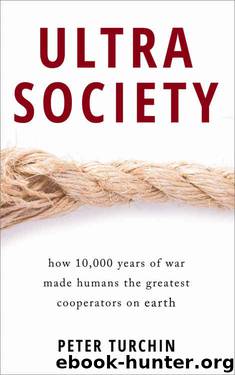Ultrasociety: How 10,000 Years of War Made Humans the Greatest Cooperators on Earth by Peter Turchin

Author:Peter Turchin [Turchin, Peter]
Language: eng
Format: epub, azw3
ISBN: 9780996139526
Publisher: Beresta Books
Published: 2015-11-16T18:30:00+00:00
Chapter 8
The Iron Law of Oligarchy
Why power inevitably corrupts
I am Tiglath Pileser the powerful king; supreme King of Lashanan; King of the four regions; King of all Kings; Lord of Lords; the supreme; Monarch of Monarchs; the illustrious Chief who under the auspices of the Sun god, being armed with the sceptre and girt with the girdle of power over mankind, rules over all the people of Bel; the mighty Prince whose praise is blazoned forth among the Kings: the exalted sovereign, whose servants Ashur has appointed to the government of the country of the four regions and has made his name celebrated to posterity; the conqueror of many plains and mountains of the Upper and Lower Country; the conquering hero, the terror of whose name has overwhelmed all regions; the bright constellation who, according to his power has warred against foreign countries and under the auspices of Bel, there being no equal to him, has subdued the enemies of Ashur. (Translated by Henry Rawlinson)
So proclaims a cuneiform text inscribed on four large octagonal cylinders of clay found by archaeologists in the ancient city of Ashur, the capital of the Assyrian Empire. Tiglath Pileser I, who ruled from 1114 to 1076 BCE, was not a modest man. In fact, he was a typical archaic king.
Other Assyrian kings left equally bombastic inscriptions. A black marble obelisk discovered during excavations in Nimrud, a major Assyrian city, depicts five kings bringing tribute and prostrating themselves before Shalmaneser III (reigned 859–824 BCE). The inscription says: “I am Shalmaneser, King of multitudes of men, prince and hero of Assur, the strong King, King of all the four zones of the Sun and of multitudes of men . . .” and so on.
Finding such propaganda from long-dead archaic kings is a huge coup for historians. To give you an idea of how long these inscriptions are, their translations into English can occupy anywhere between 10 and 30 pages of text. They yield a wealth of data on the countries, peoples, and rulers in the Assyrian geopolitical neighborhood, but my interest is in what they tell us about the archaic rulers.
The Assyrian royal propaganda texts are basically lists of military campaigns against surrounding states or rebellious provinces. They sound a lot like the old joke about joining the army: “Travel to exotic countries! Meet new people! Kill them . . .” (although in the Assyrian inscriptions, one should add, “Flay them and stretch their skins on the battlements!”) Here’s this basic formula, illustrated with some typical passages from the Tiglath Pileser inscription:
Then I went into the country of Comukha, which was disobedient and withheld the tribute and offerings due to Ashur my Lord: I conquered the whole country of Comukha. I plundered their movables, their wealth, and their valuables. Their cities I burnt with fire, I destroyed and ruined. . . . I crossed the Tigris and took the city of Sherisha their stronghold. Their fighting men, in the middle of the forests, like wild beasts, I smote.
Download
Ultrasociety: How 10,000 Years of War Made Humans the Greatest Cooperators on Earth by Peter Turchin.azw3
This site does not store any files on its server. We only index and link to content provided by other sites. Please contact the content providers to delete copyright contents if any and email us, we'll remove relevant links or contents immediately.
Born to Run: by Christopher McDougall(7066)
The Leavers by Lisa Ko(6912)
iGen by Jean M. Twenge(5367)
Sapiens by Yuval Noah Harari(5294)
The Kite Runner by Khaled Hosseini(5085)
Spare by Prince Harry The Duke of Sussex(5077)
Machine Learning at Scale with H2O by Gregory Keys | David Whiting(4192)
Bullshit Jobs by David Graeber(4101)
Never by Ken Follett(3799)
Goodbye Paradise(3729)
Livewired by David Eagleman(3686)
Fairy Tale by Stephen King(3221)
A Dictionary of Sociology by Unknown(3031)
Harry Potter 4 - Harry Potter and The Goblet of Fire by J.K.Rowling(2992)
The Social Psychology of Inequality by Unknown(2941)
The Club by A.L. Brooks(2863)
Will by Will Smith(2795)
0041152001443424520 .pdf by Unknown(2785)
People of the Earth: An Introduction to World Prehistory by Dr. Brian Fagan & Nadia Durrani(2702)
